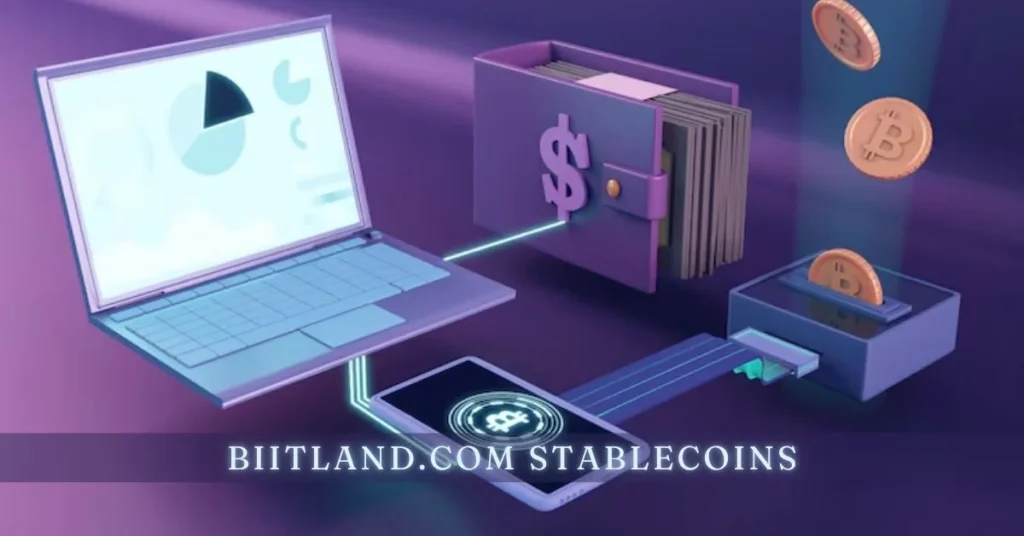Introduction to Stablecoins
Cryptocurrency is a fascinating world filled with opportunities and innovations, but it often comes with its fair share of volatility. Enter biitland.com stablecoins—an ingenious solution designed to bring stability to the chaotic crypto landscape. They bridge the gap between traditional currencies and digital assets, making transactions smoother and more predictable. Whether you’re a seasoned trader or just dipping your toes into the crypto waters, understanding stablecoins can open up new avenues for investment and trading strategies. Let’s dive deeper into what makes these digital assets so essential in today’s market!
Types of biitland.com stablecoins: Fiat-Backed, Crypto-Collateralized, and Non-Collateralized
Stablecoins come in various forms, each designed to maintain stability in different ways. The most common type is fiat-backed stablecoins. These are pegged to traditional currencies like the US dollar or euro. Each token typically represents a specific amount of real-world currency held in reserve, providing a reliable value.
Then there are crypto-collateralized stablecoins. These are backed by other cryptocurrencies instead of traditional money. They use smart contracts to manage collateral and ensure that even if the underlying asset’s value fluctuates, the stablecoin maintains its peg through over-collateralization.
Non-collateralized stablecoins operate on algorithms rather than physical assets or cryptocurrencies. They rely on supply adjustments based on market demand to stabilize prices. This can make them more volatile but also offers unique advantages for certain applications within the cryptocurrency ecosystem.
Use Cases for Stablecoins in the Crypto Market
Stablecoins serve multiple purposes in the dynamic crypto market. They provide a reliable medium of exchange, allowing users to transact without worrying about price volatility.
For traders, stablecoins simplify the process of entering and exiting positions. Instead of converting back to fiat currency, they can quickly swap into a stablecoin and hold their value during market fluctuations.
Additionally, stablecoins facilitate cross-border transactions with lower fees compared to traditional banking systems. This opens doors for global commerce and remittances.
DeFi platforms also heavily rely on stablecoins for lending, borrowing, and earning interest. Users can leverage these assets while maintaining stability within their portfolios.
Businesses are increasingly adopting stablecoins for payments due to their predictable values. This trend enhances efficiency in online transactions by eliminating conversion costs associated with fluctuating cryptocurrencies.
Importance of Stablecoins for Crypto Traders and Investors
Stablecoins play a crucial role in the crypto ecosystem by providing a reliable medium of exchange. They mitigate the volatility that often plagues cryptocurrencies, allowing traders to move funds without fear of sudden price drops.
For investors, stablecoins offer a safe haven during market downturns. Instead of converting assets back into fiat currency, they can park their investments in stablecoins and retain value.
Additionally, these coins facilitate easier transactions across exchanges. Traders can swiftly transfer between various digital assets while minimizing exposure to unpredictable price swings.
Moreover, stablecoins are essential for executing smart contracts and decentralized finance (DeFi) applications. Their stability simplifies complex financial operations like lending or borrowing within blockchain networks.
With growing adoption among platforms and services, the importance of stablecoins continues to rise as they bridge traditional finance with the innovative world of cryptocurrencies.
Risks Associated with Stablecoins
Stablecoins may seem like a safe haven in the volatile crypto market, but they come with their own set of risks.
One primary concern is regulatory scrutiny. Governments worldwide are increasingly looking at stablecoins to ensure compliance with financial regulations. This could lead to sudden changes that might affect their value and usability.
Another risk lies in transparency. Many stablecoins claim to be backed by reserves, yet not all provide clear audits or documentation. If users can’t trust these claims, it undermines confidence in the entire system.
Market manipulation poses another threat. Because some stablecoins are heavily traded, they can become susceptible to price fluctuations driven by large holders or coordinated actions within the market.
Technological vulnerabilities cannot be ignored. Hacks and smart contract bugs have plagued various cryptocurrencies, including stablecoin projects. Such incidents can result in significant losses for investors relying on these digital assets for stability.
Top Stablecoin Projects: Tether, USD Coin, Dai, and TrueUSD
Tether (USDT) is the most recognized stablecoin, often used as a benchmark in the crypto market. Its value is pegged to the US dollar, allowing users to hold and transfer funds without volatility concerns.
USD Coin (USDC) has gained traction for its transparency and regulatory compliance. Backed by reserves held in US dollars, it’s an attractive option for those seeking stability while participating in DeFi projects.
Dai stands out due to its decentralized nature. It operates on the Ethereum blockchain and maintains its peg through a system of collateralized debt positions, offering users more control over their assets.
TrueUSD (TUSD) emphasizes trustworthiness with regular audits of reserves. As another fiat-backed stablecoin, it assures holders that they can exchange TUSD for USD at any time, reinforcing confidence among investors.
Each project addresses different needs within the cryptocurrency ecosystem while aiming to provide stability during turbulent market conditions.
Conclusion
Stablecoins play a crucial role in the cryptocurrency ecosystem. They bridge the gap between traditional finance and digital currencies, offering stability amidst volatility. As more investors turn to crypto, understanding stablecoins becomes essential.
Different types of stablecoins cater to various needs. Fiat-backed options provide security through tangible assets like USD or EUR. Crypto-collateralized variants offer flexibility but come with their own risks. Non-collateralized alternatives challenge norms by relying on algorithms for stabilization.
Their utility stretches beyond trading; they enable seamless transactions, facilitate remittances, and even serve as a store of value for many users worldwide. For traders and investors, stablecoins are indispensable tools that help manage risk during market fluctuations.
However, potential risks cannot be ignored—regulatory scrutiny and transparency issues remain significant concerns within this evolving landscape. Awareness is key for anyone looking to navigate these waters safely.
Prominent projects like Tether (USDT), USD Coin (USDC), Dai (DAI), and TrueUSD (TUSD) illustrate the diversity available in the market today. Each brings unique features that address specific user needs while contributing to overall liquidity in cryptocurrency markets.
Understanding biitland.com stablecoins is not just about knowing what they are; it’s about recognizing their role as foundational elements in modern finance’s ever-changing terrain.
FAQs
What is “biitland.com stablecoins”?
“biitland.com stablecoins” refers to the stablecoin insights and resources provided by Biitland.com, offering education on how these digital assets maintain value stability and support the broader crypto ecosystem.
How do fiat-backed stablecoins maintain their value?
Fiat-backed stablecoins hold reserves of traditional currency (like USD) in bank accounts, ensuring each coin is backed 1:1, which helps maintain a stable value.
Why are stablecoins important in DeFi?
Stablecoins provide the price stability needed for lending, borrowing, and staking in DeFi platforms, allowing users to engage in financial services without high volatility.
Can stablecoins be used for international payments?
Yes, stablecoins enable fast, low-cost cross-border payments without relying on traditional banking systems or fluctuating exchange rates.
What are the risks of using stablecoins?
Key risks include lack of transparency in reserves, regulatory uncertainties, and potential vulnerabilities in underlying technology or smart contracts.






